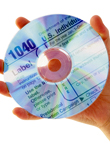 According to the IRS, more than 100 million Americans and businesses filed their tax returns electronically last year, and even more are expected to efile this year. Not only is efiling quick and easy, it can reduce errors on tax forms, expedite the refund process and alleviate the worry of having your tax return lost in the mail. However, before you logon and start putting your financial data out there, make sure your personal information is secure. The following tips will help ensure your tax returns make it to Uncle Sam’s inbox, while minimizing the chance of unwanted eyes getting a peek at what’s in your bank account.
According to the IRS, more than 100 million Americans and businesses filed their tax returns electronically last year, and even more are expected to efile this year. Not only is efiling quick and easy, it can reduce errors on tax forms, expedite the refund process and alleviate the worry of having your tax return lost in the mail. However, before you logon and start putting your financial data out there, make sure your personal information is secure. The following tips will help ensure your tax returns make it to Uncle Sam’s inbox, while minimizing the chance of unwanted eyes getting a peek at what’s in your bank account.
Protect Your Returns.
Before you begin any type of online tax work, you need to make sure your computer is secure and protected. The only thing worse than no tax refund would be losing your financial records to a virus, or inadvertently sharing those records with the outside world. Make sure you protect yourself and your system with the latest antivirus and antispyware software, install effective wireless security and firewalls, create passwords in combinations of numbers and letters, and change them frequently.
Plan Ahead.
Check out software or online tools that can make life run more smoothly. Current options include Quicken, or the free online tool, Mint.com. Consider some of these tools to help you stay organized throughout the year. If you own your own business, calendar your tax year in advance so that quarterly payments and forms are submitted on time. You can even easily program email reminders so that you don’t miss a deadline. Also be sure to catalog receipts and deductions via spreadsheets throughout the year, so that tax time is much less stressful. Finally, be sure to check with your bank for any new applications they may have. Different types of financial software can speak directly to your bank, making checkbook balancing, bill paying and record keeping much simpler.
Do Some Research.
Although there are many legitimate free federal efile services available, consumers need to be wary of offers for free tax services. Some scammers create official looking emails to dupe recipients into entering personal information that leads to identity theft. Whenever you are entering in personal financial information, double check that the HTML address in your web browser starts with https://, as opposed to http://. The “s” in https:// means the site is secure. Some trusted efile providers include www.efile.com and www.eztaxreturn.com. These sites are secure and offer step by step instructions.
Save Data and Delete Stress.
Backup, backup, backup. Accidents will happen, but losing a year’s worth of tax records should not be one of them. Purchase an external hard drive and regularly backup your important financial data to the drive. Printing out your financial records isn’t a bad idea either.